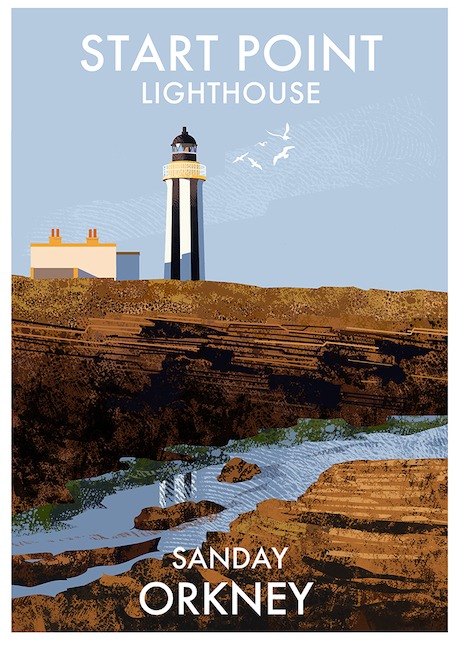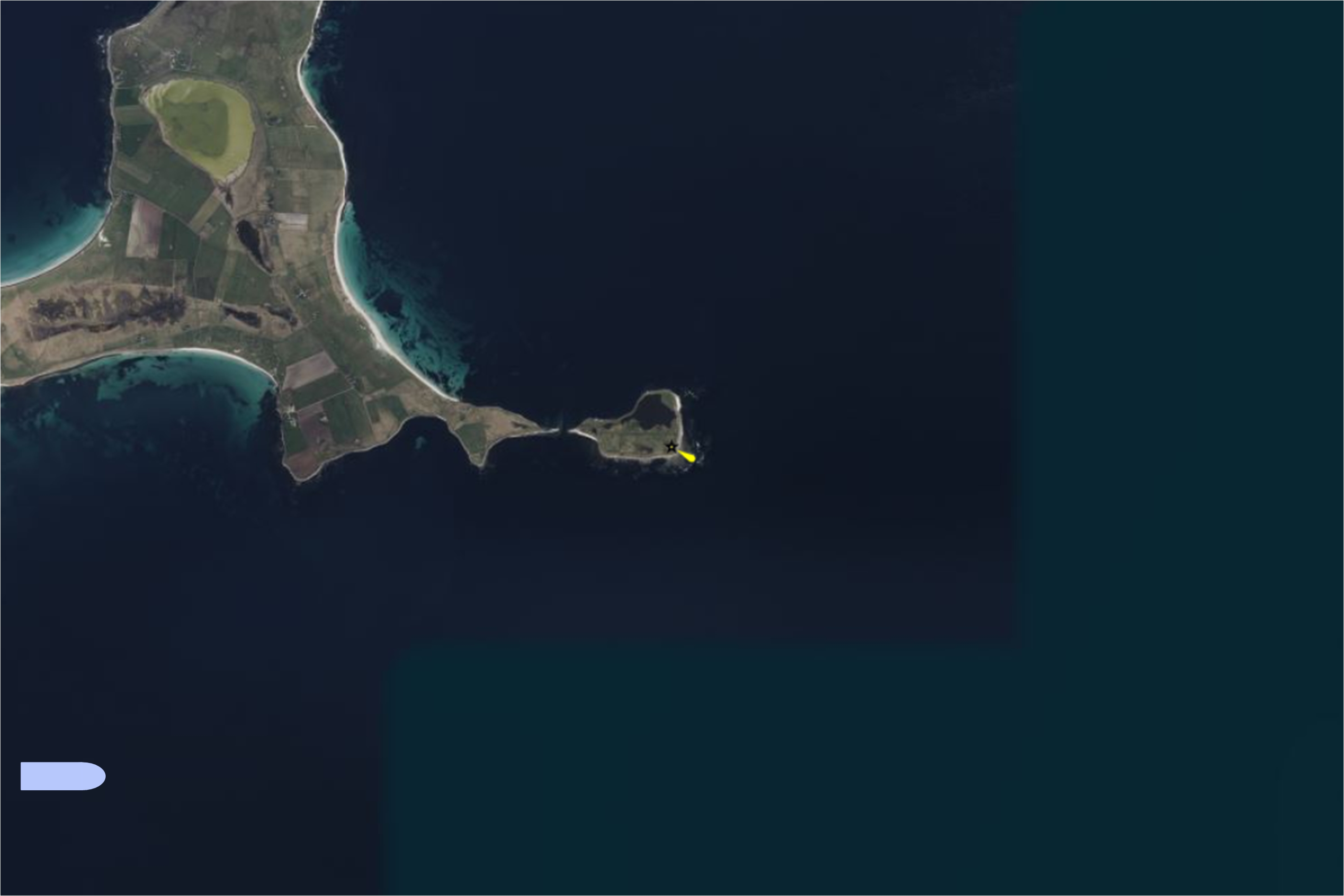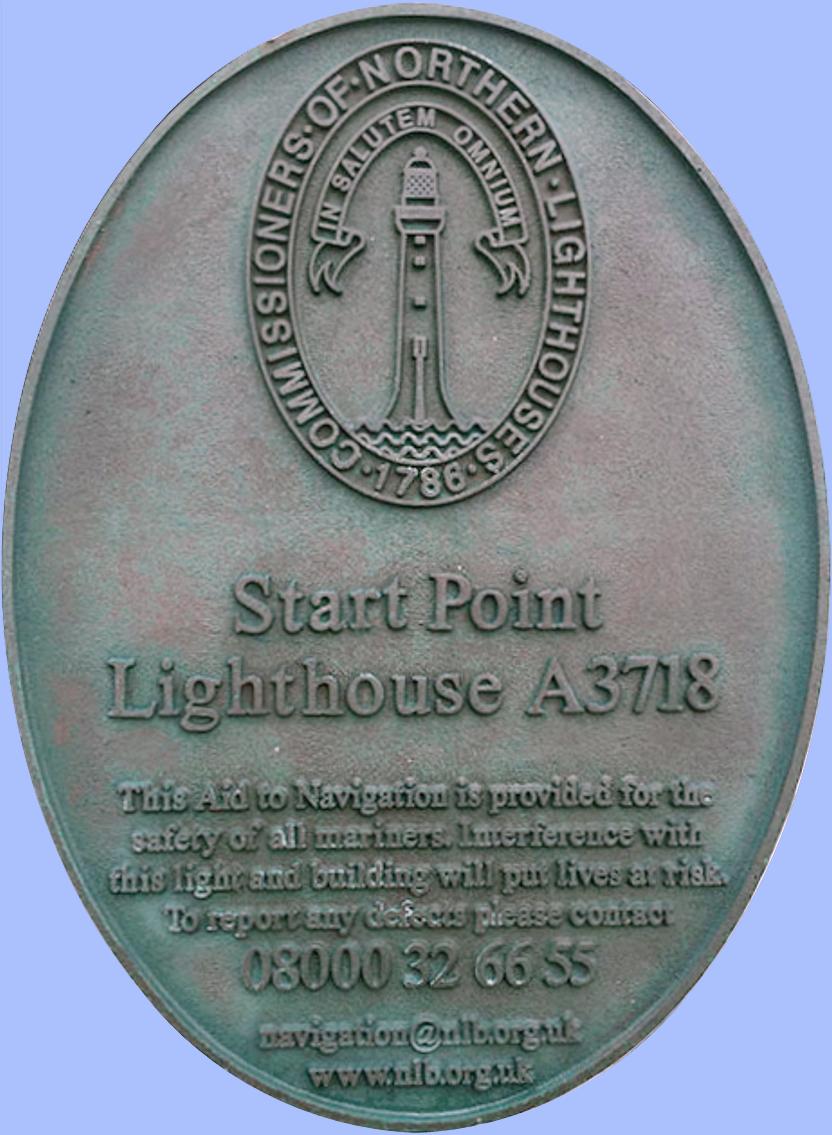
Place of the lighthouse
Building of the Lighthouse
Warning systems (Light, Fog horn, Radar Beacon)
Operational status
Information about the lighthouse specific
Additional information
See also the NLBWinter Jouurnal 2020 Description c. 1880. Brick. Short tower. Circular plan. 2-storeyed Keepers' houses, with platformed roof, at base. Statement of Special Interest Now automatic. Replaced lighthouse built 1802-6. Sanday is one of the inhabited islands of Orkney that lies off the north coast of mainland Scotland. With an area of 50.43 square kilometers (19.5 sq mi),[3] it is the third largest of the Orkney Islands.[8] The main centres of population are Lady Village and Kettletoft. Sanday can be reached by Orkney Ferries or by plane from Kirkwall on the Orkney Mainland. Start Point lighthouse on Sanday was completed on 2 October 1806 by engineer Robert Stevenson. It was the first Scottish lighthouse to have a revolving light and since 1915 has exhibited distinctive black and white vertical stripes which are unique in Scotland. The light was automated in 1962 and is powered by a bank of 36 solar panels.[35] Despite the presence of the lighthouse, HMS Goldfinch was wrecked in fog on Start Point in 1915.[36] The first beacon to mark the Start Point on the Orkney island of Sanday was an unlit masonry tower, but this beacon proved inadequate as vessels continued to be wrecked on the island. At the time Robert Stevenson was engineer to the Northern Lighthouse Board and he decided to transfer the light from the neighbouring island of North Ronaldsay to Start Point. Building work began and the new lighthouse, which is still in existence, was established and first exhibited on 2 October 1806. The original great ball from the top of the first beacon was removed and placed on the old beacon at North Ronaldsay - this can still be seen today. Start Point was the first Scottish lighthouse to have a revolving light which gave it a unique character making it easily distinguished from other lights. Start Point lighthouse was painted with its black and white vertical stripes around 1915, which makes it a recognisable day mark; it is the only Scottish lighthouse painted in this way. Disaster struck during the building of Start Point lighthouse when the vessel "Stromness" set off to return the workmen back to Leith. A tremendous storm blew up forcing the "Stromness" back northwards to shelter off Flotta island. During the night the cables broke and she was smashed to pieces on the rocks with the loss of all on board except the cabin boy, who was found clinging to the top of the mast. All Scottish lighthouses now operate automatically. The last Scottish lighthouse to be automated was Fair Isle South in 1998. Now, when daylight falls and rises between set levels, a light sensor switches the light on and off. The status of the light and all its associated equipment is relayed back to the Northern Lighthouse Board's head office in Edinburgh by phone link, Radar signal or satellite. Prior to the automation of Start Point in 1962 a Principal Lightkeeper and an Assistant, with their families, lived at the light. The families were almost self sufficient and would have kept cows and sheep at the station. Lightkeeping was a remote, lonely and hard existence. At night each keeper was required to keep a watch in the lightroom to ensure that the light flashed correctly to character. During daytime keepers were engaged in cleaning, painting if necessary and generally keeping the premises clean and tidy. The magnificent lens at Start Point is an original 4th Order Fresnel lens, with a new lamp system. So named after its French inventor, Augustin Fresnel. It is made from a series of perfectly polished crystal glass lenses set into a brass structure. An emergency back-up light is positioned on the balcony should the main light ever fail. Start Point Lighthouse is powered by Solar energy; a bank of 36 solar panels charge batteries which are then used to power the light. The Northern Lighthouse Board has successfully used solar energy at its lighthouses for over 20 years and have also converted all its statutory lit buoyage to solar power. Start Point Lighthouse was the first Scottish Lighthouse to have a revolving light making it easily distinguishable from other lights. It was painted with its unique black and white stripes around 1915 and is the only Scottish lighthouse painted in this way. Situated on a tidal island at the exposed eastern point of Sanday, Orkney, Start Point Lighthouse was the first Scottish Lighthouse to have a revolving light making it easily distinguishable from other lights. It was painted with its unique black and white stripes around 1915 and is the only Scottish lighthouse painted in this way. 1870 (Thomas Smith and Robert Stevenson). Station established 1806. Active; focal plane 24 m (79 ft); two white flashes, separated by 2.5 s, every 20 s. 23 m (75 ft) round stone tower with lantern and gallery, painted with black and white vertical stripes; lantern painted black. The 2-story keeper's house is occupied as a private residence, but the owner also looks after the lighthouse informally. Beth Loft's photo at right was taken on the 200th anniversary of the light station, 2 October 2006. Trabas has Ina Rendtel's closeup photo, a 2007 view is available, Marinas.com has aerial photos, and Google has a satellite view. Huelse has a historic postcard view and a second postcard view that shows the lighthouse painted with the present vertical stripes. This is the easternmost lighthouse of Orkney, located on a small island off the northeastern tip of Sanday Island. Sanday is accessible by ferry, and the lighthouse can be reached on foot at low tide; Lukas Pokorny has a view of the crossing point. Tours guided by the owner of the island are available. Site and tower open by appointment. Operator: Northern Lighthouse Board. ARLHS SCO-225; Admiralty A3718; NGA 3276. Start Point lighthouse on Sanday was completed on 2 October 1806 by engineer Robert Stevenson. It was the first Scottish lighthouse to have a revolving light and since 1915 has exhibited distinctive black and white vertical stripes which are unique in Scotland. The light was automated in 1962 and is powered by a bank of 36 solar panels.[35] Despite the presence of the lighthouse, HMS Goldfinch was wrecked in fog on Start Point in 1915.[36]
NLB Journal.... Northern Lighthouse Board Journal Winter 2020 Start Point Lighthouse 150th Anniversary 1870-2020 Roderick Thorne and his wife Sylvia moved to Sanday in 1984. Roderick was Head Teacher at the island’s school and retired in 1997. In 2005 he was appointed by the island’s Development Trust to be Sanday’s first Ranger, a post from which he retired in 2015. In this fascinating article, Roderick tells the story of the second lighthouse on Sanday which turned 150 years old this year. Roderick Thorne In 2006, Sanday’s Lighthouse celebrated its bicentenary with a number of guided visits to the tower organised by the Northern Lighthouse Board and Sanday’s Development Trust. That same year on 6 August, 60 folk joined Roger Lockwood, the then Northern Lighthouse Board’s Chief Executive, as he unveiled a commemorative plaque (photograph above). The guided tours proved so popular that monthly visits remained an attraction for visitors throughout subsequent summer seasons until this year. As far back as the sixteenth century, Jo Ben wrote of this treacherous stretch of Scotland’s coast: “There is a dangerous point called the Star (sic) of Lopness, where so many English and German vessels perish.” In 1782 a series of storms around Britain’s coasts, was reckoned in folk memory, to have been worse than those that had wrecked the Spanish Armada in 1588. Just four years later, in 1786, a House of Commons Bill proposed the establishment of a Board of Commissioners with the authority to build lights in Scotland’s most dangerous sea areas. Within a month the Bill became a Statute, and the first four to be established were on the Mull of Kintyre, Eilean Glas, Kinnaird Head, and North Ronaldsay. Their success in reducing the incidence of shipwrecks was soon recognised, and another Act of Parliament allowed the Commissioners powers to establish more lighthouses “upon any parts of the coast of Scotland as they shall deem necessary.” The foundation of Start Point tower, first constructed as an unlit beacon, was laid with Masonic honours on March 15th 1802, and completed the same year. By then local opinion had already dismissed it as unsuitable, so it was designed with conversion in mind. In a letter to the Commissioners the Rev. William Grant of Sanday had listed twenty two shipwrecks that had occurred in the area since 1788, and pointed out that since most of them had happened at night, only a lighthouse could serve any useful purpose. This recommendation was accepted, and the famous Thomas Smith and his apprentice Robert Stevenson were engineers for the project. It can’t have been easy for Robert to engender local support; the local minister was reputed to pray devotedly every Sunday for those in peril on the sea, to ask God politely if He intended to sink any ships soon and, if so, whether He couldn’t organise it so they were wrecked on Sanday. 6th August 2006 - RLK Andrew Skea 2nd left, Roger Lockwood 3rd left The Notice to Mariners that appeared in the Edinburgh Evening Courant of November 4th 1805 indicated that Start Point would be lit on the first day of the new year. In fact it was not until October 2nd that Sanday’s revolving light – the first such apparatus in Scotland – was first illuminated. Start Point’s new Lighthouse had not only made the original Sanday beacon-tower unnecessary, but now, too, the North Ronaldsay Lighthouse was considered redundant; it ceased operating in 1809 (it was later reinstated), and the lantern was replaced by a very large masonry ball which had been taken from the old Start Point beacon three years earlier. That stone ball remains intact atop the original North Ronaldsay Light, which for many years now has been shrouded in scaffolding.The author Walter Scott joined Robert Stevenson and other Commissioners on their summer voyage of inspection in 1814. He wrote: “at the Start of Sanda, a lighthouse has been erected lately upon the best construction….All in excellent order and the establishment of the Keepers in the same style of comfort and respectability as elsewhere – far better than the house of the master of the Fair Isle and rivalling my own baronial mansion of Abbotsford.” Despite such a high standard of accommodation, domestic life was not quite so easy. Scott noted: “there is one dreadful inconvenience of an island life, of which we have here an instance. The Keeper’s wife had an infant in her arms – her first-born, too, of which the poor woman had been delivered without assistance.” Daniell’s aquatint of 1821 (photograph 2) shows this first lighthouse, which served for sixty years. On February 12th 1867, the Orkney Herald carried a Notice to Mariners about the imminent lighting of the Auskerry light – a fixed white light and presumably to avoid confusion, Start Point would change to a red light. Soon after, Sanday’s Lighthouse was rebuilt and this year that structure is 150 years old. Tom Kent’s photograph - photograph 3 - was taken around 1910 from the seaward side. In 1919 the unique black and white stripes were first painted on over the brickwork. An astute Light Keeper, in 1931, listed the date, along with other noteworthy events in the Visitors’ book - photograph 4. The Daniell illustration shows the tower is in the foreground, the Keepers’ domiciles behind, and the sea in the background, with Fair Isle making an appearance on the left-hand side of the horizon. When the changes were made to the structures in 1870; the tower was rebuilt on the seaward side of the living quarters (photograph 5 opposite). What was the reason for the rebuild, though? Possibly, during their regular inspections, the Stevensons, whose standards were the very highest, decided that the original building material – local stone – was too friable and unsound. Craig Mair, author, in 1978, of A Star for Seamen, had access to the private Stevenson family papers; describing the original lighthouse, he wrote: It was originally intended to build the tower of masoned stone, but since time was short Robert decided to build with rubble instead. The new tower was certainly made of imported brick. It seemed that, for some sensible reason, the Stevensons decided to relocate and rebuild the lighthouse closer to the sea, on the other side of the accommodation. At the time of writing, during the Coronavirus lockdown, there has been no access to the National Library of Scotland, which holds the personal papers of the Stevenson family. It seems likely that those documents will hold the explanation for the ‘new’ tower; and provide the answer to an even bigger mystery. Sanday’s Heritage Centre holds copies of the original plans for the Start Point buildings (photographs 6 and 7) and the design of the most important feature, the light room and light mechanism. These plans were gifted by the Northern Lighthouse Board at the time of the bicentenary of the original Lighthouse. A comparison of the 1806 plan with a present-day map or aerial image of the area, indicates that all of the buildings, the accommodation block included, were rebuilt in their present location (photograph 8). In a letter to the Commissioners the Rev. William Grant of Sanday had listed twenty two shipwrecks that had occurred in the area since 1788, and pointed out that since most of them had happened at night, only a lighthouse could serve any useful purpose. The move was less than fifty metres, and the old Keepers’ accommodation (which Walter Scott had compared favourably with his own baronial mansion) was demolished. The Light Keepers’ Register records the men who were involved in the transfer. They were: Principal Keeper, James Smith entered service at Start Point on 4th September 1867, and stayed for 12 years, transferring to Sanda, off the Mull of Kintyre, in September 1879. 5. Start Point Lighthouse in 2020 6. 1806 Plan (A) 7. 1806 Plan (B) 8. 2006 Aerial view of Start Point



 Update: 01-03-2025
Update: 01-03-2025





